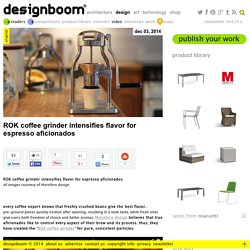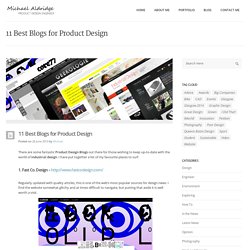

Bring Composting to Your Countertop with the Jarst Planter. Tired of saving your fruit and veggie scraps only to have to carry them to another location to compost?

You’ll be happy to hear that designers Leonardo Fortino and Andrea Bartolucci have developed an ingenious solution for precisely this problem: Jarst. Featuring a seal drum and cap inside a traditional flower pot, Jarst brings composting right to your countertop and makes sure plants get the nutrients and energy they need to stay happy, healthy, and in some cases, delicious.
Fresh basil, anyone? Fairly simple in its construction, Jarst is comprised of only three main components: a pot/composter, an inner diaphragm, and a cap. Just drop your organic waste into the composter, put the cap on, and let nature take its course. STUDIOMAMA.
Yujuichou. TYCKA DESIGN : Industrial Design firm based in Banglore, India. When design & craft meet. When design & craft meet Fernando & Humberto Campana Circus Rug 2010 Design is a young discipline.

A process engineered at the beginning of the industrial age that first and foremost developed function and derived beauty from it. Industrial design. ASSA ASHUACH STUDIO © ROK coffee grinder intensifies flavor for espresso aficionados. Dec 03, 2014 ROK coffee grinder intensifies flavor for espresso aficionados ROK coffee grinder intensifies flavor for espresso aficionadosall images courtesy of therefore design every coffee expert knows that freshly crushed beans give the best flavor. pre-ground pieces quickly oxidize after opening, resulting in a stale taste, while fresh ones give users both freedom of choice and better aromas. therefore design believes that true aficionados like to control every aspect of their brew and its process. thus, they have created the ‘ROK coffee grinder‘ for pure, consistent particles. video courtesy of therefore design the product requires less than have the amount of revolutions as the standard model, only taking approximately 30 seconds to create a double espresso.

Adjusting the coffee grind the project is currently looking for funding on indiegogo here. Core77 / industrial design magazine + resource / home. Thought Leadership from the Products of Design Blog. Designbuzz : Design ideas and concepts. Design News - Dexigner. Industrial Design and Innovation Blog, AUT. Yanko Design - Modern Industrial Design News. 10 excellent blogs about industrial design. 50 Best Blogs for Industrial Design Students. From fabulous furniture to amazing tech products, the work of industrial designers is all around you.

If you’re currently pursuing a college degree in the subject or plan to in the future, you can get your fix of all thing industrial design on the web. Here are 50 blogs that anyone interested in learning more about great product design should check out, with news, stunning photos and tips that can help you improve your skills in the field. Must-Read These blogs contain some excellent reading for anyone considering a career in industrial design or who already works in the field. Core 77: This is one of the best online resources for industrial designers. 10 Great Blogs for Product Design. There are some fantastic Product Design Blogs out there for those wishing to keep up-to-date with the world of industrial design.

I have put together a list of my favourite places to surf. 1. Fast Co. Design – Regularly updated with quality articles, this is one of the web’s most popular sources for design news. 2. A different website to the rest, this website is changing the way many business source funding for a project. 3. A web magazine containing examples of the best designs from around the world. 4. The most corporate of all the websites list here, but don’t let that put you off. 5. Products Made to Fail and Break. They just don’t make things like they used to – intentionally!

If products lasted for years, then we wouldn’t have to replace them and manufacturers wouldn’t make as much money. Thus, starting in the 1950s and 1960s, manufacturers consciously decided to make products that were designed to fail and break. If you haven’t heard of this conspiracy to rip your hard-earned dollars out of your pocket over and over again, that may be because business gave it a fancy name. The term “Planned Obsolescence” refers to the practice of intentionally designing goods to fail and break after a set time period of “acceptable life” once purchased. Instead of being dismissed as a lousy idea and a way to cheat consumers, is it any surprise that it was embraced by businesses everywhere?
Printer Inks: The amount of ink left in your printer is measured by a microchip, which shuts off printing when levels are below a certain amount. Nylons: The original nylon was used for parachutes by the military in WWII. Designed to fail. By Nick Meynen.

While violent conflicts over rare metals used in our phones and laptops continue and e-waste keeps piling up, engineers break their heads over new ways to ensure that products die quicker. It takes 244 kg of fossil fuel, 21,8 kg of chemicals and 1.5 tons of water to manufacture one computer and monitor. Carsten Wachholz, product policy officer from the European Environmental Bureau: “To offset the energy consumed to manufacture a laptop, it must be used for more than 20 years, even with a 20-30% efficiency improvement rate over that time”.
The opposite is happening: computers made in 2010 have a 10% shorter lifespan than those made in 2000[1]. The same goes up for cell phones, iPods and so on. Planned Obsolescence - Products Designed to Fail. Some have complained that cell phones seem to follow planned obsolescence, although it is also true that handsets endure heavy daily use, and often do wear out.

Plus, cell phone technology has been proceeding apace. MP3 players, on the other hand, seem to be designed with more rapid planned obsolescence in mind. Unlike many gadgets, these units are rarely upgradable with more memory, meaning consumers are more likely to buy a whole new unit after they fill up their old one. But perhaps even more aggravating is planned obsolescence of proprietary batteries -- typically lithium-ion -- that are found in many MP3 players (in addition to laptops, cameras and some other devices). In the worst case, such as with Apple iPods, the battery can't be removed easily by consumers, forcing an expensive service request when it runs out -- inconveniently priced just below replacement cost of the whole unit, and encouraging a throwaway mentality.